“The time has come, the walrus said…”
Well, this is it. In less than two hours I’ll be heading back to the Ben Gurion airport in Tel Aviv to start my trek back to Boston, back to real life and my regular routine. While I’m happy to be heading back into my own space and known world, I know that I will deeply miss my experiences here.
I haven’t posted in a few days despite having things to say. While some of what I’ve seen has been new, relevant and interesting, part of it seems like I’d be rehashing my words. So why not have one grand summary post, shall we?
I left Boston ten days ago with a mixture of fear, excitement and adventure. I was worried about my personal safety (I mean, you hear what they say on the news…), excited about what I’d see and hear, and knowing that each day would hold a completely new experience. While my fears turned out to be unfounded, my other emotions were filled in spades. I am returning to Boston now wiser, wearier and worldlier and a completely new person.
This trip has provided so much information (almost to the saturation point) about the conflict and occupation. I now better understand the political situation, as well as some of the viewpoints of the Israelis and the Palestinians. I now understand that this is not really a war based on religion but on politics, land and economic opportunity. I always knew that both the Israeli and Palestinian people have a right to share the land and a right to happiness and equality. I now know that the largest perpetrators of the violations of human rights and international law is the Israeli military and government. Not the people. I have a better understanding of the sufferance of the Palestinian people and the daily hardships they have come to know.
This trip has armed me with stories. In America, we hear statistics and stories portraying Palestinians as the terrorists. We hear only about the good works that Israel is doing (which they are, but it’s not the whole story). Now I have seen the human face of the conflict; know stories of settlers, refugees, displaced persons and villagers. I have heard from Palestinians rich and poor, Israelis to the left and to the right and know where they stand and know the variances of their positions.
Most of all, I am reinvigorated. My purpose has been reborn. I’ve always known that I have wanted to create change, but this trip has revealed to me that my purpose in life is to give a voice to the voiceless; to speak for those who cannot speak for themselves. I want to be able to change the way of life for the Palestinian and Israeli people to one of peace and community. I want to be able to help the Palestinians and Israelis tear down the apartheid wall. I want to enable those who cannot help themselves.
This leads me down only a slightly different path than I was planning on before. I’ve known that I want to seek higher degrees in International Affairs and Public Policy, and I believe those will still be helpful in my quest. However, what my meetings over the past few days have shown me is that working with the laws and policy can really help bring the greatest results.
So what does that mean? Law school.
I’ve been pondering this idea for the past two years or so; running the gamut from determined to downright iffy. Yet meeting today at the Eshan Center for Human Rights in Bethlehem had me make up my mind. The law can directly help people, giving their voices a structure and a background. The International Affairs will give a breadth of a background in the Middle East and the developing countries that my heart aches for and the Public Policy will inform on the how and the what of change.
I know a great deal of work is ahead. Work in school and work to build my method and plan to inform the world of injustice. But I’m ready to take this on. I’m ready to start making a tangible difference in this world and I’m ready to improve the lives of others. I’m ready to sacrifice time and ready to improve myself through education and through doing.
I’m ready.
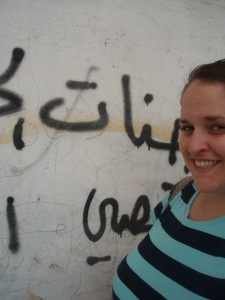
Rose in the Middle of a Sidewalk
Each and every meeting we have brings on a new sense of hope, optimism and understanding, particularly from the Palestinian community. While I never subscribed to the Bush administration’s idea of the Arab world “hating us for our freedoms,” I always thought that we, as Americans, would not be their favorite people.
I’ve been proven wrong.
Each and every person has been so accommodating to our group, telling us how welcome we are and going out of their way to be gracious hosts. I have never felt afraid or threatened while I was here, neither from the Israelis or the Palestinians.
It seems that the Palestinian community is really trying to grow; prove to the world that they can live their lives happily and not continue to be victims (or breed the stereotypical suicide bomber/terrorists we have come to associate with the nation as a whole). We visited the largely unknown town of Qalqilia today, which is located on the edge of the West Bank. Part of its lands were partitioned off to Israel in the 1948 UN Partition Plan (aka the Green Line), but since then, the Israeli military has built a wall completely around the city, annexing the land around Qalqilia for its rich agricultural capabilities. International news media has labeled the city as “the largest jail in the world.” Through the city, there were four entrances/exits, one at each end. Now only the eastern end is open, the rest blocked off and watched my armed Israeli soldiers.
We met with the mayor and several other municipality officials, who outlined their hopes for their ravaged city. Despite the huge unemployment rates (28-35%) and poverty level, they all remain hopeful that they will be able to change things around.
Inside of Qalqilia is a small zoo and “entertainment center” that houses a delicious restaurant, a few amusement park rides and a large playground. Many women walked around with their small children and it was amazing to see a bright and happy place amidst the general dreariness of cement walls and barbed wire that surround the town.
Proof that no matter what happens, there will always be the silver lining inside of a cloud.
Tourist or Terrorist?
For the record, I am writing this post under American distress – computer problems. I tried to connect wirelessly via the hotel connection at my hotel in Nablus, Palestine, but it seems that I am one of the few with troubles. So I am instead persevering on a slow desktop. I know, not really a big deal, but quite annoying all the same.
Anyways.
Today gave me a sense of optimism about this whole situation entirely. We met with a Jewish Israeli woman, representing the organization Peace Now. She specifically works on their “Settlement Watch” program.
I believe it was vital for our group to meet with her, because she brought a new viewpoint for us to examine: anti-occupation, pro-Palestinian state and Jewish Israeli. She feels that the tides are turning for everything, including the general Israeli population. More and more support and understanding is growing around the unfairness of the settlements and this can help lead to a greater internal grassroots movement. She also revered the “Obama effect,” the Arab nation’s proposed peace plan with Israel and the recent changes in Israeli government. What was the greatest benefit to my understanding of the problem was it coming from the viewpoint of a progressive (and religious) Israeli. While it added yet another shade of grey to my comprehension and decisiveness on the conflict, it gave me greater understanding. I can now appreciate the Israeli side of things more within the frame of peace.
Moving on from there, we visited a Palestinian refugee camp: 13,000 people living on one square kilometer in a run down section of Bethlehem. I was saddened, appalled and again inspired by what I saw: people working together to make the most of their grim situations. Children are being raised to think broadly, creatively and peacefully instead of becoming incensed with hatred and revenge. Despite their small (and at sometimes squalid) living arrangements, the sense of community was tangible, and made my own soul stronger.
Yet tonight, while traveling to Nablus in Area A of Palestine (otherwise known as the small area controlled completely by the Palestinian Authority), we hit a check point where the very young Israeli soldier opened our van door. At most of them we are waved through without a second glance, or perhaps some questions are asked of our Arab driver and/or tour guide or about our nationalities. Tonight he opened the door, looked around at our expectant faces, and then shut it and waved us on. I asked our tour guide, Ibrahim, what the purpose of it was. He jokingly said “I told him you were American tourists, and he wanted to make sure that you were tourists, not terrorists.”
The levels of security at the check point varies. Sometimes the soldiers barely glance at us as we pass, but other times I’ve noticed cars and other drivers getting a serious shakedown. People can sometimes stand for hours in their car waiting to pass through. What matters is the color of your license plate. Yellow is Israeli (our van has one of these) and Green or White with green writing is Palestinian. Those without yellow plates are often the ones most harassed. Yet even when stopped, the level of investigation is variable and subjective. Apparently all of our sweet, All-American apple pie faces said we were merely tourists, but we could easily have hidden something in the car.
This fact has not fazed me, despite the inherent worry it brings. It just makes me think about the Israeli justification for the entire occupation, “security” in quite a different way.
Hope this makes you question it as well.
I Bought an Olive Tree
Yes. An olive tree. No worries about customs though; it was in name only. This afternoon we visited a farm dubbed “The Tent of Nations.” It’s a large farm owned by a Palestinian family that is being threatened for takeover by the Israelis. It is surrounded by settlements on all sides, and despite the family holding the deeds from 1920, the Israeli government is trying to claim it as state land so they can build on it. A legal battle for the land has been raging on for years, and despite this, the family is making good use of it. Without electricity, running water, or a permit to build, the family is running a successful farm and camps throughout the year for volunteers and a summer camp for children. Aside from olives and grapes, they build bridges between people; showing that we are all human beings.
I found the work and perseverance of the whole operation to be inspiring. They are working the direct face of adversity and thriving.
Come spring time, an olive tree will be planted in my name on their farm, atop a mountain. To find out more about them, please see their website at http://www.tentofnations.org.
We also visited the largely Palestinian city of Hebron, touring the old city, visiting their main mosque and meeting with the group Christian Peacemaker Teams (CPT). Hebron is completely under Israeli military control, and are even stationed at the entrance to the mosques. I saw one military officer harass an elderly Muslim woman today as she tried to make her way in to pray. She continued to set off a metal detector and I don’t think understood why she was being held up. The officer was yelling at her and kicked her at one point. Very distressing to see. What more is that the street vendors (what is left of them, anyways) have to string nets between their shops to catch all the trash and rocks that are thrown down on them from the settlers above.
There has to be a better way for people to share space without diminishing the other.
We also met with a Jewish settler today. We listened respectfully as he spoke about his reasoning for moving to Israel and to the Ephrata settlement, and objected to the terms of “occupation,” preferring to call it “administering.” While he had fair points (all sides do), and understood that both sides have done right and wrong in the decades-long conflict. Yet I feel like his argument was not completely aware of the inherent unfairness in how things are “>currently. I respect his and all Jews who hold these views at this land is sacred to them as well, but there needs to be more common ground.
Tonight is the last night with our host family in Palestine. We return to hotel overnights starting tomorrow. I finally feel comfortable with the family (and the food!) and I recommend home stays for anyone travelling abroad. At least for one night.
My mind is feeling non-linear tonight, and I hope to have a more eloquent post for you tomorrow.
Take some time tomorrow to do something heartfelt and selfless. Find your own olive tree.
Just a Quick Word from Palestine
Apologies for not being able to update – I am spending three nights with a host family in Beit Sahour, Palestine. Only the father speaks English, so our interactions are limited but it’s proven to be an interesting experience.
We’ve spent yesterday and today in Palestine and the occupied territories. I’ve been learning a great deal about the occupation and blatant human rights violations and breaches of international law being committed daily by the Israelis – it’s apartheid for the Middle East.
I’m meeting amazing, strong and passionate people here in Palestine. A boy in a market in Nablus even hit on me! We’ve been to a university, a phenomenal Arab Women’s Union Society that has built a successful hospital for the ground up, and even a soap factory.
As I’m not on my own computer I can’t post any pictures but I will share this story about water in Palestine.
The Israelis living in the West Bank (occupied territories), although having a much smaller population, control most of the water. Ramallah, a major city in Palestine, only receives water regularly about three times a week. Some of the more remote villages get water about once a month. So all houses in Palestine have these black water holding tanks on their roofs to ensure that when they aren’t already provided water that they can still access some.
It’s just practices like these that make the daily lives of Palestinians so difficult, and want me to commit to working for their just human rights.
Not sure if I’ll be able to update tomorrow, but we will be seeing an Israeli settlement, meeting with a Christian peace group, and seeing Hebron.
And remember, being against the occupation is not being against Israel.
Human Rights, Holocaust and Refuseniks
**Note: It was pointed out to me that I have been using the term “Jewish” interchangeably with “Israeli” and similarly with “Muslim” and “Palestinian.” Please note that many of these observations about current behaviors are not based on religious differences but on cultural. I do not wish to label each Israeli as Jewish nor Palestinian as Muslim as I would not label every American as Christian. Please keep this in mind while reading my accounts and I will try to correct my language.**
I am blogging to you now from my hotel room, listening to the melodic call to worship for the city’s Muslims. It occurs throughout the day, but I have only been around an area with mosques in the evening times. Hearing the calls, although in Arabic, is simultaneously soothing and exciting, as I feel privileged to hear and witness such a religious and sacred ritual.
Today was both full and fulfilling. We began the day meeting with B’Tselem, a human rights organization working within the occupied territories. They work within the scope of international and human rights law to make sure that both Israelis and Palestinians are staying within legal confines. Hearing a presentation by researcher Eyal Haleveni, we learned a great deal about current human rights violations. Primarily we spoke about Israeli attempts to annex more land in the West Bank (the West Bank of the Jordan River) with their building of a wall. This new area is nearly twice as long as the borders defined by the “Green Line” or the 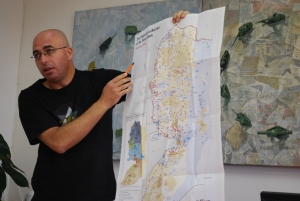 borders agreed upon after the 1948 war. Apparently it’s largely for real estate reasons (and economic incentives for Israelis to move into settlements on this new land) and not exactly for security reasons as officially cited.
borders agreed upon after the 1948 war. Apparently it’s largely for real estate reasons (and economic incentives for Israelis to move into settlements on this new land) and not exactly for security reasons as officially cited.
Largely, when they learn about human rights violations, they report it. Most recently, they were able to capture two violations on video and shared them with the Israeli military and the international media, which forced official investigations into these amoral behaviors, causing results.
The first of these are Israeli settlers beating an elderly Palestinian couple and the second was an Israeli army personnel shooting a Palestinian man at point blank range with a rubber bullet. Both of these incidents were for little reason besides the others were Palestinian. Because of B’Tselem’s work, these are now treated as criminal actions by the army instead of minor misdemeanors.
Again, please note that B’Tselem is concerned with Palestinian human rights violations too, we just discussed Israeli ones at our brief meeting today.
Next we went to Yad Vashem, the most important Holocaust memorial in Israel. This well-plotted museum was beyond moving and presented material and personal experiences I have not been able to understand in 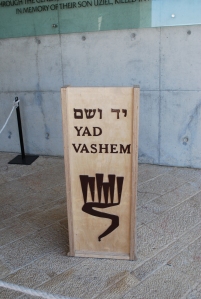 all my past study of the subject and visits to other memorial museums. It chronicles antisemitism from its start as a religious prejudice, which of course became more social in the early 20th century. It also follows the plight of the Jews and other persecuted peoples from the ghettos and pogroms until liberation near the end of WWII.
all my past study of the subject and visits to other memorial museums. It chronicles antisemitism from its start as a religious prejudice, which of course became more social in the early 20th century. It also follows the plight of the Jews and other persecuted peoples from the ghettos and pogroms until liberation near the end of WWII.
New things I learned:
- Poland, not Germany, had the highest population of Jews (and number of murders) by the start of WWII
- The Soviet Union had the second highest population of Jews but also the highest number of survivors
- The number of Jews in Germany was a surprisingly low number: less than 1% of the total population (they had more time to leave the country with the slow onslaught of antisemitic laws and regulations)
- Many Jews were not allowed to leave their homelands in search of peace as many countries did not want to take them on (including Switzerland, Britain, Cuba and the US)
- Hitler and the Nazi leaders planned to exterminate 11 million Jews, including in countries that weren’t occupied by Germany such as the Scandinavian and Iberian countries and Britain. Of course the Allies’ strength in Western Europe prevented this from happening
- There was an uprising of the people left in the Warsaw ghetto; people who fought for their freedom
- Only 3.5 million of the 6 million Jews who were murdered during the Holocaust have been identified by name. Yad Vashem is working to find as many more identities that they can.
- 1.5 million children were killed in the Holocaust, and are memorialized beautifully at the museum
Next was a quick stop off at Deir Wassin, an old Palestinian village that was largely destroyed (save for a few old houses that still stand) and has been repurposed as the site of an Israeli Mental Health hospital. Many of the original residents of this village were massacred by terrorists in April 1948, right before the creation of the state of Israel. It was also the motivation for many other Palestinians to leave once they heard about the violence being committed in order to build settlements.
We next headed into the En Kerem village, an artsy little village down the mountain from Jerusalem. It was originally a home for Palestinians and Christians, and now houses many Israeli artists. It has biblical significance as it is where Elizabeth lived while she was pregnant with John (the Baptist – his birthplace is also a church to visit) and where Mary visited. There we had an incredible lunch and then met with a refusenik, Peretz Kidron in his beautiful garden (decked out for the end of Sukkot). He spoke on behalf of the organization Yesh Gvul. His picture is below.
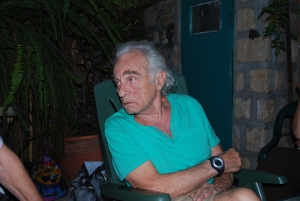
The movement today is being reinvigorated by high school age refuseniks who refuse to enter the army at all, citing that all jobs in the army serve the occupation in some way. Although their refusal changes the course of their future drastically, I admire the chutzpah and strong sense of morality and belief that these Israelis hold and their refusal to take part in such an awful form of discrimination. It reminds me of how powerful people can be once they all unite under one powerful idea. I left the meeting feeling inspired.
I am feeling overall completely lucky to be here and to experiencing all of this first hand. And I’m learning that this is what I want to do with the rest of my life.
Blood of the Same Color
I am inspired, motivated and moved.
Tonight we received two representatives from the Parent’s Circle, a large organization of bereaved Palestinian and Israeli families. They come together to share their stories with the world, and talk about how they have all found common ground in working together to find a way towards peace.
An Israeli Jew and Palestinian Muslim man shared their stories of loss, each heartbreaking in its own way. Yet what was incredible is that both of these men said that instead of growing angry and finding vengeance upon their “enemy,” they chose to find understanding. While they could grow angry each day, they instead work to educate the world about the issues surrounding the conflict and occupation.
What was most remarkable to me was the presentation. Framing it with the human experience is something that literally everyone can relate to. While the problems of the Middle East might not matter to many of those across the world (particularly in America), hearing about the blatant human rights violations these people have experienced first hand is appalling. Hearing them both realize that Palestinians and Israelis are “human beings, with blood the same color, pain the same pain and tears just as bitter” plucked my heartstrings. What was best for me, though, was the diplomacy of the whole experience.
Since college I have been a huge proponent of public diplomacy via cultural understanding: bringing experiences to those of other cultures to garner more knowledge and compassion. These personal stories do just that. I was inspired by what this organization is doing; finding a common ground approach towards humanizing peace.
What more is that I found reassurance (so early! I know!) that this truly is what I want to do with my life: creating international change organically through advocacy. Their approach invigorated me and pushed me towards a new level of nirvana of learning on this trip.
I head to bed tonight eager for the historical menu of tomorrow’s agenda, but ready to put all this knowledge into constructive and peaceful action.
I’ve arrived (and already followed Jesus…)
We arrived in Tel Aviv this afternoon around 2:30pm local time, with a brief foray in Rome. (Not impressed with the Rome airport or the flight staff of Alitalia – more on that later). We met up with two of our fellow travelers from Minnesota and made our way to Jerusalem in a van driven by an Arab man named Mohammed.
Our hotel for the first two nights, Holy Land Hotel, is right in the middle of East Jerusalem, which is primarily a Palestinian area (although there are Jewish neighborhoods here as well). From the window in my hotel room, I can see into the “Old City” and the famous gold dome of the Rock of the Dome, an area sacred to both Jews and Muslims. Simply gorgeous. 
We were also able to do a little unscheduled exploring before dinner tonight, and the group of us walked around, down by the ancient Old City wall (built in the 1500s) and saw Herod’s and Damascus Gates. This was where Jesus was lead to his crucifixion, now known as the stations of the cross.
We stopped into a shop run by an Armenian family (Armenian Catholics represent a small population of Jerusalem today, many still residing in the Old City) where we spoke with the proprietor about bargaining, Armenia, the Jerusalem cross and the city itself. He also told us a little about the stations of the cross, and Station #5 is located right outside of his shop.
For those of you who didn’t grow up Catholic (even for those, like myself, who did and need a refresher course), station #5 is where Jesus began to falter for a second time and rested his hand upon a stone. That 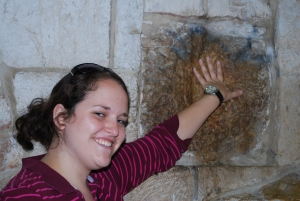 stone is still there, and visitors and pilgrims are able to touch it. Directly experiencing that piece of history was so meaningful to me, despite having left the Catholic church years ago. I even took a picture with it!
stone is still there, and visitors and pilgrims are able to touch it. Directly experiencing that piece of history was so meaningful to me, despite having left the Catholic church years ago. I even took a picture with it!
It has been an a huge learning experience for me already: seeing first hand some of the persecution that the Palestinians have endured since the 1967 Six Day War. The Palestinians have been relegated to small villages, literally fenced in with their roads blocked so they cannot travel (driving or walking) on the same road as the Jews. It drew many parallels for me with racial segregation in the United States.
I want to update more about what I saw today and my impressions, but I am being consumed by jet lag. I do want to add one note about my blog over the next two weeks: these are just my impressions on what I’ve seen. I don’t lean either way; I am just as pro-Israel as I am pro-Palestine. I realize that there are far more than two sides to this whole conflict and anything mentioned here should not be regarded as my firm belief in any one argument. Each and every person and ancestry has suffered and gained a great deal over the genesis of this sacred land, and can be just as culpable as the next.
Tomorrow we will be exploring more of Jerusalem, so look out for more pictures on my Flickr page!
Finding Reassurance in Israel
We all need confirmation in our lives; reassurance that we’re on the right path and following the best dream. I’ve posted before about questioning my stance in life, wondering if I had really found my purpose. So to reassert what I’ve thought to be my future livelihood, I’m going back to the start. Everyone’s start.
Tomorrow afternoon I leave for a two-week trip to Israel and Palestine. I will be joining a group of eight others from the Unitarian Universalists for Justice in the Middle East, traveling the West Bank and northern part of the country to learn more about the conflict and occupation. We’ll be meeting with peace advocates, academics, government officials (from both sides), refugees, and Israeli and Palestinian citizens to understand the climate and work towards finding the bricks to build a roadway to peace.
This isn’t a “mission” per say; there is no conversion involved. But I see it as a public diplomacy trip – one emulating the UN. I hope we can glean (and leave) a bit of cultural understanding.
The trip will reinvigorate my soul and goals; reasserting that international affairs (along with public policy) with a focus on the Middle East is where I want my path to lead. I expect my life to be completely changed within the course of the next two weeks; my eyes reopened, my intellect challenged, my sense of justice ignited.
I will be repurposing Falling Feet First for the next two weeks to recount my trip: the sights, sounds, smells and experiences, complete with pictures. Armed with my brand new Nikon D60 (thanks Mom and Dad!), I will capture this culture and next step in life.
Perhaps we all don’t need to leave the country to find reassurance, but this unique opportunity has posed itself at just the right time.
Please keep me in your thoughts for safe travels over the next two weeks – I’ll carry them with me like a flame.